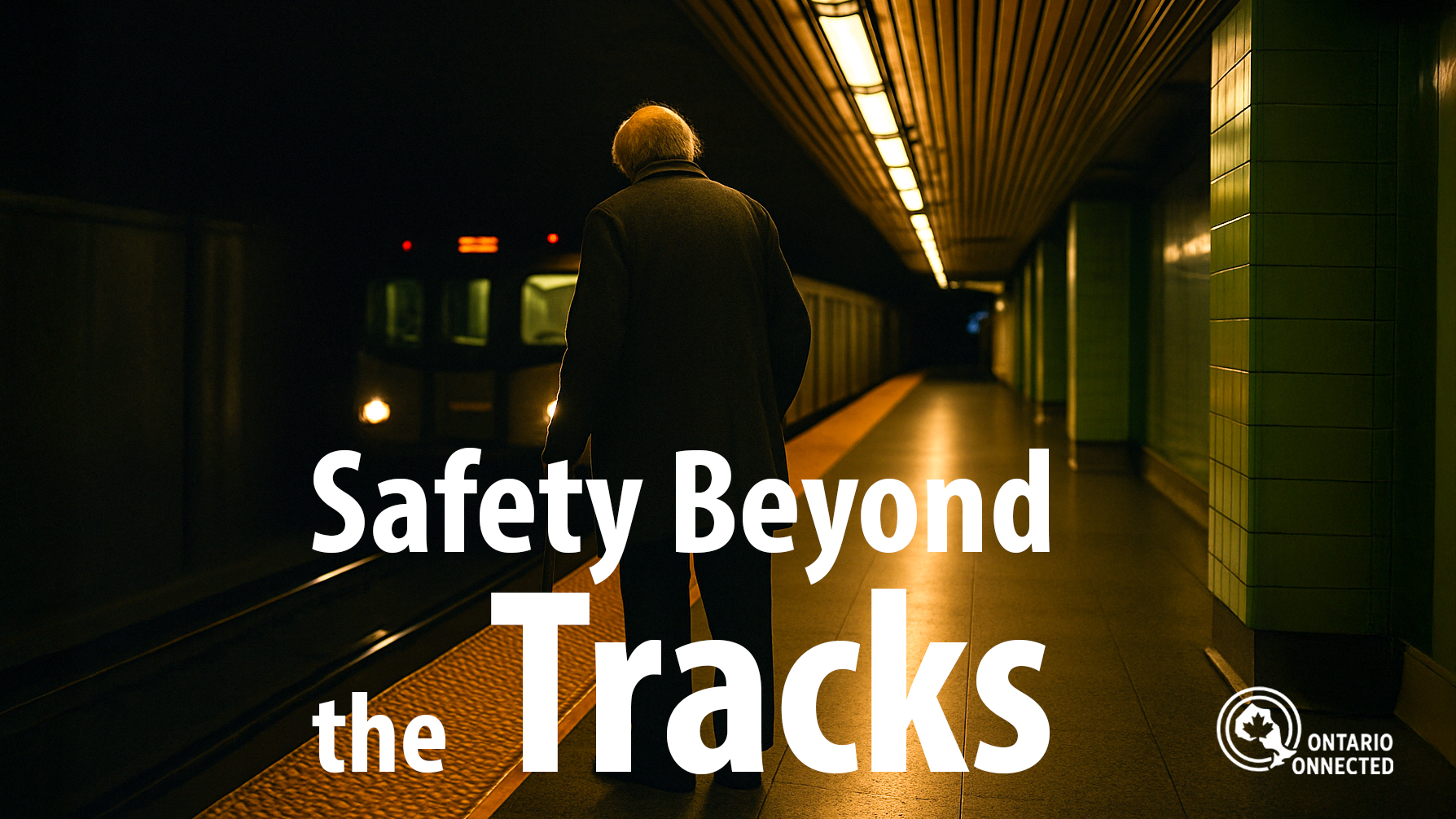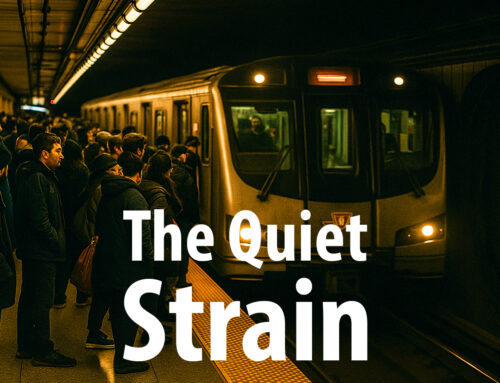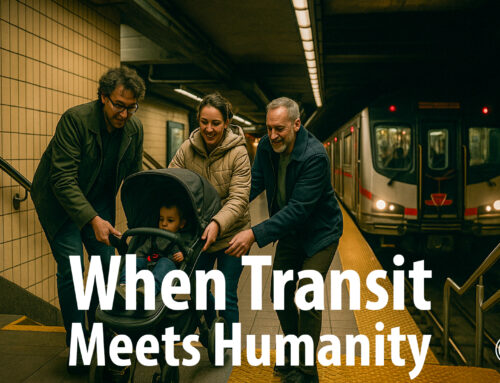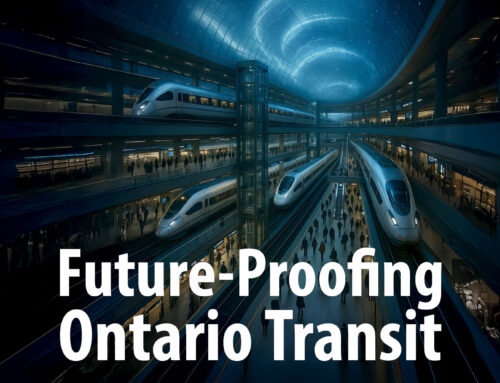You’re reading Part 1 of 4 in the Operator’s Window series — stories from the cab of Toronto’s subway.
-
Part 1: Safety Beyond the Tracks (you’re here)
Introduction
It was close to midnight when I pulled into one of the quieter stations. The platform lights flickered faintly against the tiled walls, casting long shadows where no one should have to wait alone. Near the yellow line stood an older woman, her hands tightly gripping a purse as she shifted her weight nervously from one foot to the other.
Most riders on my train didn’t notice her. They were tired, scrolling through their phones, eager to get home. But from my seat in the cab, I could see it clearly: she wasn’t just waiting for a train. She was measuring her safety against her need to travel.
Moments like this remind me that transit safety isn’t only about signals, alarms, or cameras. It’s about people — their dignity, their fears, and their trust in the system.
Safety Is More Than Technology
When people hear about subway safety, they usually think of technical systems: the signaling network that prevents trains from colliding, the cameras lining every platform, or the emergency alarms built into each car. And yes, those tools are critical. But the truth is, a train can be perfectly safe on paper while riders still feel unsafe in practice.
A spotless incident record doesn’t comfort the senior stranded at a station with a broken elevator. A row of cameras doesn’t ease the anxiety of a young woman standing alone at midnight. A functioning alarm system doesn’t erase the fear that prompts someone to pull it in panic, halting thousands of riders down the line.
From the cab, I can tell you: safety is not just measured in accidents avoided. It’s measured in the confidence riders feel — or don’t feel — every time they step onto a platform.
What Operators See
Most riders see their commute in slices: a crowded car, a few minutes’ delay, maybe an announcement they barely hear. Operators see the whole ripple.
When an emergency alarm goes off, I hear the dispatcher’s voice in my headset, I feel the train grind to a halt, and I know the impact will ripple down the line. Thousands of people will be delayed, trains will stack behind me, and Transit Control will scramble to minimize the disruption. But behind all of that technical juggling is often something simple: someone felt unsafe.
I see the gaps cameras don’t cover. I notice when a platform feels too dim, when corners create blind spots, or when riders hesitate before boarding because the environment doesn’t feel welcoming.
These aren’t just inconveniences. They’re barriers — invisible but powerful — that keep people from trusting the system fully.
Safety as Dignity
Transit should never make people feel small, vulnerable, or forgotten. Yet that’s what happens when safety isn’t designed with dignity in mind.
- Seniors who skip trips entirely because stations feel overwhelming or unsafe.
- People with disabilities stranded when elevators are broken or hard to access.
- Unhoused riders who find no resources or support in the stations they shelter in.
- Young riders who hesitate to travel at night because platforms feel too empty or too threatening.
These are not fringe cases. They’re daily realities. And every time someone avoids the system out of fear, the system has failed its most basic purpose: to serve people equally.
The Ontario Connected Vision
Ontario Connected imagines a different kind of future — one where hubs are designed not just for speed, but for safety and dignity at every step.
Think of the way world-class airports operate. Bright lighting eliminates dark corners. Clear signage directs people confidently. Staff and security are visible everywhere, not just in emergencies. Even massive terminals feel safe to walk through because design makes them predictable and open.
Why should transit be any different? Imagine a high-speed rail hub at Union Station where seniors glide across moving walkways, where platforms are brightly lit and fully accessible, where staff presence reassures riders instead of reacting only after something happens.
This isn’t luxury design. It’s safe design — and it’s the baseline Ontario should demand for its future.
Building Safety Into the System
If Ontario is serious about future-proofing transit, safety must be designed in from the start, not added later as an afterthought. That means:
- Visibility: open layouts, transparent materials, and lighting that removes blind spots.
- Accessibility: elevators, ramps, and moving walkways that always work, so no one feels trapped or dependent.
- Human presence: ambassadors and staff trained not only for emergencies, but to provide comfort and guidance.
- Technology that supports, not replaces: real-time alerts, clear communication, and systems that empower staff to respond instantly.
- Integration with community services: healthcare, shelters, and social services accessible right at hubs, so vulnerable riders are supported, not just moved along.
These are not small changes. They are cultural shifts that make transit a place where people feel they belong, no matter who they are or when they travel.
A Story That Stays With Me
One night, long after rush hour, I watched as a blind rider stepped off a platform edge with his cane, tapping carefully toward the train. Before I could make an announcement, three strangers guided him gently to a seat.
It was a beautiful moment of humanity. But it also revealed a flaw: he shouldn’t have needed strangers to ensure his journey was safe. The system itself should have been built to guide him confidently, without relying on luck and kindness.
That night, I thought: this is what Ontario Connected is about. Designing a system where every rider, no matter their age, ability, or circumstance, can travel with dignity — not dependence.
Why This Matters for Ontario’s Future
If we want seniors to age in place, if we want young people to choose transit over cars, if we want every Ontarian to feel included, safety must be more than an operational metric. It must be emotional, visible, and constant.
Ontario is on the cusp of building high-speed rail, regional hubs, and expanded subway networks. The choices we make now will decide whether those systems are trusted or abandoned. Safety isn’t optional. It’s the foundation of trust — and trust is the only way to build ridership.
This story is part of the Operator’s Window series — real perspectives from the cab about what it takes to keep Ontario moving. If you found this piece meaningful, you may also want to explore:
-
Part 1: Safety Beyond the Tracks (you’re here)
Conclusion
From the cab, I see both the technical side and the human side of safety. I see how quickly a small delay ripples into frustration. I see how dim corners or broken elevators quietly tell people: this space wasn’t built for you. And I see how kindness often fills the gaps where the system falls short.
But kindness isn’t a substitute for design. Ontario has the chance to build a system where safety is never in question — where seniors don’t hesitate, where youth don’t feel afraid, where vulnerable riders aren’t invisible.
That’s the Ontario Connected vision: a transit future where safety is not just measured in operations, but in dignity. Because safety beyond the tracks is what truly makes a system worth trusting.






Leave A Comment
You must be logged in to post a comment.